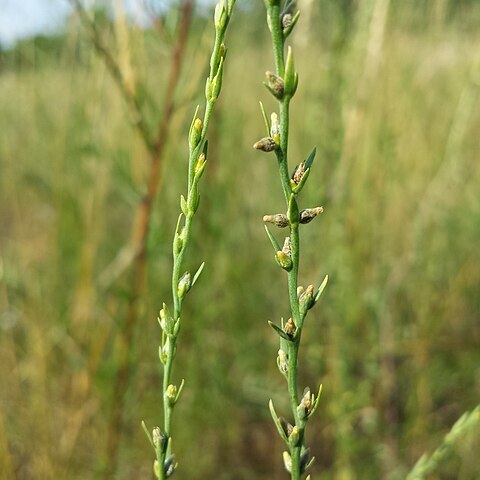Annual herb, erect, 0.2–0.7 m high. Stem usually with several slender erect branches, glabrous or slightly hairy at apex. Leaves linear or narrowly lanceolate, acute, glabrous; lamina 5–20 mm long; petiole to 0.5 mm long. Flowers bisexual, in upper axils, usually 1–3 per axil; bracts 2 per axil, ovate or narrowly ovate, 2–3 mm long, long-ciliate towards base. Hypanthium and sepals greenish yellow, 2–3 mm long, densely short-hairy, persistent in fruit. Sepals erect, ovate, 0.5–0.8 mm long. Stamens included. Style terminal, not exserted beyond sepals; ovary distally hairy. Seeds 2–2.5 mm long.
Stems green or yellow-green, turning red in fall. Leaves upright; petiole to 1 mm; blade 0.6–1.5 × 0.1–0.2 cm, stiff, herbaceous to coriaceous, apex acute. Inflorescences cymose, 1–7-flowered; bracts 1.5 cm, with tuft of white trichomes at base. Flowers: hypanthium green to yellow, tubular, becoming urceolate, 2–3 mm, appressed-hairy; calyx lobes minute; stamens: distal whorl inserted at throat; distal anthers subexserted; ovary 0.75 mm, apex hairy; style 0.7–0.8 mm, glabrous, becoming ± eccentric in fruit; stigma exserted. Capsules pyriform. 2n = 18.
Taprooted annual to 6 dm, simple or with long, ascending branches; herbage glabrous or nearly so; lvs small, narrow, to 15 × 2.5 mm, with a jointed, cartilaginous base, fls 1–3 in the axils, 2–3 mm; hypanthium short-hairy, shortly 4-lobed, scarcely corolloid; fr ovoid, 2 mm, with thin pericarp appressed to the hard, black seed; 2n=40. Disturbed places; Eurasian sp., intr. in O., Ill., Wis., Io., Neb. and Kans. Apr.–Sept.

